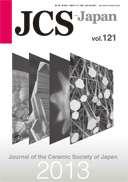Volume 117, Issue 1362
(February)
Displaying 1-20 of 20 articles from this issue
- |<
- <
- 1
- >
- >|
Special Articles
The 62th CerSJ Awards for Academic Achievement in Ceramic Science and Technology: Review
-
2009 Volume 117 Issue 1362 Pages 133-138
Published: 2009
Released on J-STAGE: February 01, 2009
Download PDF (923K)
The 62th CerSJ Awards for Academic Achievement in Ceramic Science and Technology: Paper
-
2009 Volume 117 Issue 1362 Pages 139-142
Published: 2009
Released on J-STAGE: February 01, 2009
Download PDF (416K)
Papers
-
2009 Volume 117 Issue 1362 Pages 143-146
Published: 2009
Released on J-STAGE: February 01, 2009
Download PDF (657K) -
2009 Volume 117 Issue 1362 Pages 147-151
Published: 2009
Released on J-STAGE: February 01, 2009
Download PDF (829K) -
2009 Volume 117 Issue 1362 Pages 152-156
Published: 2009
Released on J-STAGE: February 01, 2009
Download PDF (1327K) -
2009 Volume 117 Issue 1362 Pages 157-161
Published: 2009
Released on J-STAGE: February 01, 2009
Download PDF (932K) -
2009 Volume 117 Issue 1362 Pages 162-165
Published: 2009
Released on J-STAGE: February 01, 2009
Download PDF (368K) -
2009 Volume 117 Issue 1362 Pages 166-170
Published: 2009
Released on J-STAGE: February 01, 2009
Download PDF (785K) -
2009 Volume 117 Issue 1362 Pages 171-174
Published: 2009
Released on J-STAGE: February 01, 2009
Download PDF (796K) -
2009 Volume 117 Issue 1362 Pages 175-178
Published: 2009
Released on J-STAGE: February 01, 2009
Download PDF (807K) -
2009 Volume 117 Issue 1362 Pages 179-184
Published: 2009
Released on J-STAGE: February 01, 2009
Download PDF (741K) -
2009 Volume 117 Issue 1362 Pages 185-188
Published: 2009
Released on J-STAGE: February 01, 2009
Download PDF (434K) -
2009 Volume 117 Issue 1362 Pages 189-193
Published: 2009
Released on J-STAGE: February 01, 2009
Download PDF (551K) -
2009 Volume 117 Issue 1362 Pages 194-197
Published: 2009
Released on J-STAGE: February 01, 2009
Download PDF (814K)
Technical reports
-
2009 Volume 117 Issue 1362 Pages 198-202
Published: 2009
Released on J-STAGE: February 01, 2009
Download PDF (776K) -
Photocatalytic ability of TiO2 porous film prepared by modified spray pyrolysis deposition technique2009 Volume 117 Issue 1362 Pages 203-207
Published: 2009
Released on J-STAGE: February 01, 2009
Download PDF (740K)
Notes
-
2009 Volume 117 Issue 1362 Pages 208-210
Published: 2009
Released on J-STAGE: February 01, 2009
Download PDF (358K) -
2009 Volume 117 Issue 1362 Pages 211-213
Published: 2009
Released on J-STAGE: February 01, 2009
Download PDF (296K) -
2009 Volume 117 Issue 1362 Pages 214-216
Published: 2009
Released on J-STAGE: February 01, 2009
Download PDF (445K)
Express letter
-
2009 Volume 117 Issue 1362 Pages 217-220
Published: 2009
Released on J-STAGE: February 01, 2009
Download PDF (468K)
- |<
- <
- 1
- >
- >|
